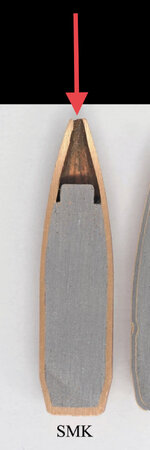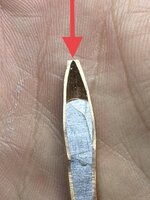Perhaps organic wasn’t the right word. The gel in the recoil tv video back on page 1 of this thread is Clear Ballistics gel and is not the opaque Knox gelatin. There is nothing wrong with using the clear stuff, but it does compare 1:1 with results from Knox gelatin. You tend to get less stretch and smaller wound channels in the clear stuff. The issue was they reported the impact velocity in meters and it was basically muzzle velocity (roughly 2800 fps for those of us on this side of the puddle). If you have that long of a neck before the bullet upsets at muzzle velocity, it’s going to be a lot longer at something like 400 yards. That just means less damage and less reliable upset at hunting ranges. Like Form said, reduced velocity gel tests that mimic real world hunting distances just tell you a lot more about how a bullet will perform.I believe the gel used in the video is yellow organic. I also don’t think it matters what range and what speed as long as it is consistently compared bullet to bullet. i.e. bullets ABC look like this and bullets XYZ look like that when fired into the gel. The gel does not not show you what the bullet is expected to do at all impact velocities, nor is it meant to
Navigation
Install the app
How to install the app on iOS
Follow along with the video below to see how to install our site as a web app on your home screen.
Note: This feature may not be available in some browsers.
More options
Style variation
You are using an out of date browser. It may not display this or other websites correctly.
You should upgrade or use an alternative browser.
You should upgrade or use an alternative browser.
Norma golden target bullets?
- Thread starter BarCO
- Start date
How are you able to tell from the video what kind of gel they are using?Perhaps organic wasn’t the right word. The gel in the recoil tv video back on page 1 of this thread is Clear Ballistics gel and is not the opaque Knox gelatin. There is nothing wrong with using the clear stuff, but it does compare 1:1 with results from Knox gelatin. You tend to get less stretch and smaller wound channels in the clear stuff. The issue was they reported the impact velocity in meters and it was basically muzzle velocity (roughly 2800 fps for those of us on this side of the puddle). If you have that long of a neck before the bullet upsets at muzzle velocity, it’s going to be a lot longer at something like 400 yards. That just means less damage and less reliable upset at hunting ranges. Like Form said, reduced velocity gel tests that mimic real world hunting distances just tell you a lot more about how a bullet will perform.
- Joined
- Oct 22, 2014
- Messages
- 13,370
Got it.
Is there a way to tell from the cross section I posted which of the two I have? At what velocity have you noticed variable results?
So look at the size of the SMK open tip-

Golden Target-

What that will tend to show is more variable depth of penetration in the Golden Targets before yawing (tumbling) than SMK’s and way more than Bergers; and with the thicker jacket will inhibit fragmentation.
I’ve used Knox gelatin for over 20 years, mostly as glue for woodworking. I’ve also made it from scratch from hide and hoof scrapings simmered in water until they dissolve. It isn’t that transparent.How are you able to tell from the video what kind of gel they are using?
@Formidilosus at what minimum velocity are you seeing reliable expansion from ELDM and other tipped match bullets?
- Joined
- Oct 22, 2014
- Messages
- 13,370
@Formidilosus at what minimum velocity are you seeing reliable expansion from ELDM and other tipped match bullets?
In general 1,800fps is about the lower limit. Even at 1,800fps impact sometimes ELD-M’s and X’s will exhibit less than optimum upset.
260284
WKR
- Joined
- Oct 21, 2019
- Messages
- 427
I know this is an old thread, but my sons and I have killed over 30 Kansas white tails with the 130 golden target in the Prime offering and handloads with great terminal performance. Good penetration and blood trails a blind man could follow. I do take a small orifice bit to the hollow points to make sure they are open and clear. Also, my farthest shot with them was 435 yards with 2785 fps at the muzzle.And the 143 might perform much differently. But the 130's are forever on my sh*t list. lol
260284
WKR
- Joined
- Oct 21, 2019
- Messages
- 427
That damage is what I have seen with the 130s out of 6.5 creeds. We have taken a lot of deer from 50-430 yards and the results are always a quarter to golfball or bigger exit and lots of blood to trail if they go anywhere. Most everything drops withing 20-50 yards.I shot a caribou 3 times with the 143 out of a PRC at 160 yards. MV 2960fps
First shot killed it, but I’m of the mindset to keep shooting until the animal drops. Follow up shots were within 1-2s of the prior shot. So it took approximately 5 seconds for the animal to hit the ground.
Of the three shots, all of which hit around 1” from the point where the heart and lungs meet, two passed through and the third was caught on the far side hide.
When I cut the animal open, damage to the vitals was catastrophic. About the size of a football. Exit wounds were about Golfball sized. This is very consistent with what you can see on YouTube when Norma shoots it into ballistic gel. It’s the same with the Berger, Hornady eldx/m
I chose this bullet because I get the most consistently tight groups with it, it has extremely low es and sd for factory ammo
and have shot a lot of PRS with it. I know how well my gun that I can consistently shoot with that particular ammo.
On the tundra, I don’t need a blood trail so as long as I hit the animal square, it’s gonna die where I can see it.
I wouldn’t hesitate to shoot any North American animal with it in open country.
260284
WKR
- Joined
- Oct 21, 2019
- Messages
- 427
Ruag used to make all the Prime ammo. I have a lot of the Prime headstamped Norma brass and it is some good stuff. My son shot a lot of it for PRS and then we started loading our own with the 130 Golden Target.Pricing on the 6.5 CM offerings (130 & 143) is roughly $0.10 higher than Hornady 140gr BTHP (American Gunner). Potentially worth trying just for the brass upgrade.
wind gypsy
"DADDY"
- Joined
- Dec 30, 2014
- Messages
- 12,648
To me, yes. The golden target bullets are a little slicker as well.Pricing on the 6.5 CM offerings (130 & 143) is roughly $0.10 higher than Hornady 140gr BTHP (American Gunner). Potentially worth trying just for the brass upgrade.
260284
WKR
- Joined
- Oct 21, 2019
- Messages
- 427
Definately a more consistent better quality bullet.To me, yes. The golden target bullets are a little slicker as well.
At what minimum velocity would you shoot a moose with the Norma 147 Golden Targets?In general 1,800fps is about the lower limit. Even at 1,800fps impact sometimes ELD-M’s and X’s will exhibit less than optimum upset.
Similar threads
- Replies
- 1
- Views
- 300
- Replies
- 53
- Views
- 2K
- Replies
- 3
- Views
- 306
Featured Video
Latest Articles
- TT#64 Josh Boyd Elk Hunting Strategies for Every Season
- Aaron Davidson of Gunwerks
- TT#63 Dirk Durham’s Art of Elk Calling
- BIG Buck Stories with the Dirty Giants Podcast
- TT#62 Brian Barney Hunting Bulls without Calling
- Hoyt Alpha AX-2 SD Review
- Kuiu Kenai vs Outdoor Vitals Vario Hooded Jacket Review
- Hoyt RX-9 Ultra Review
- Hunting Vampire Bucks & Building an Optics Kit
- Darton Sequel ST2 35 Review
